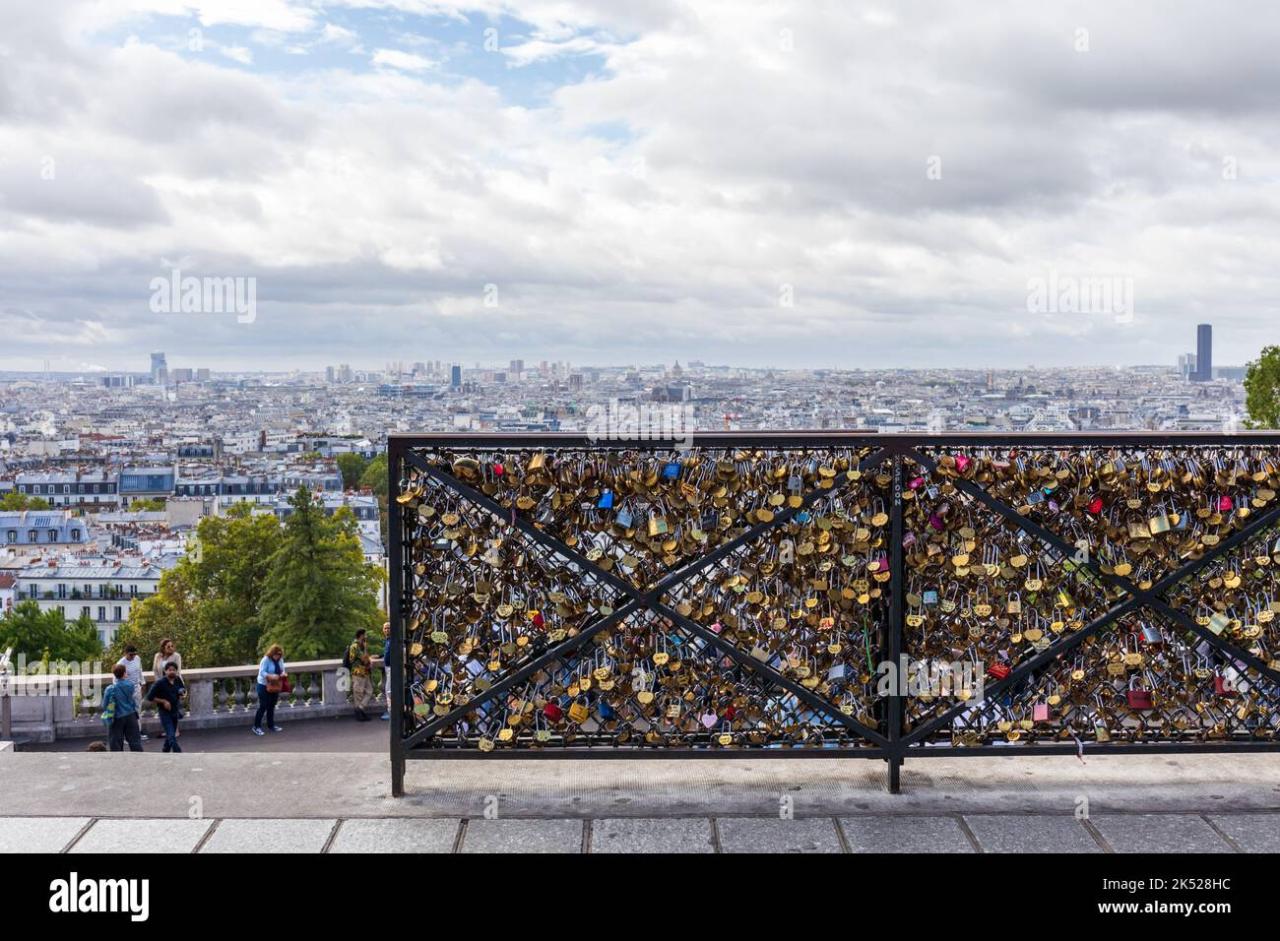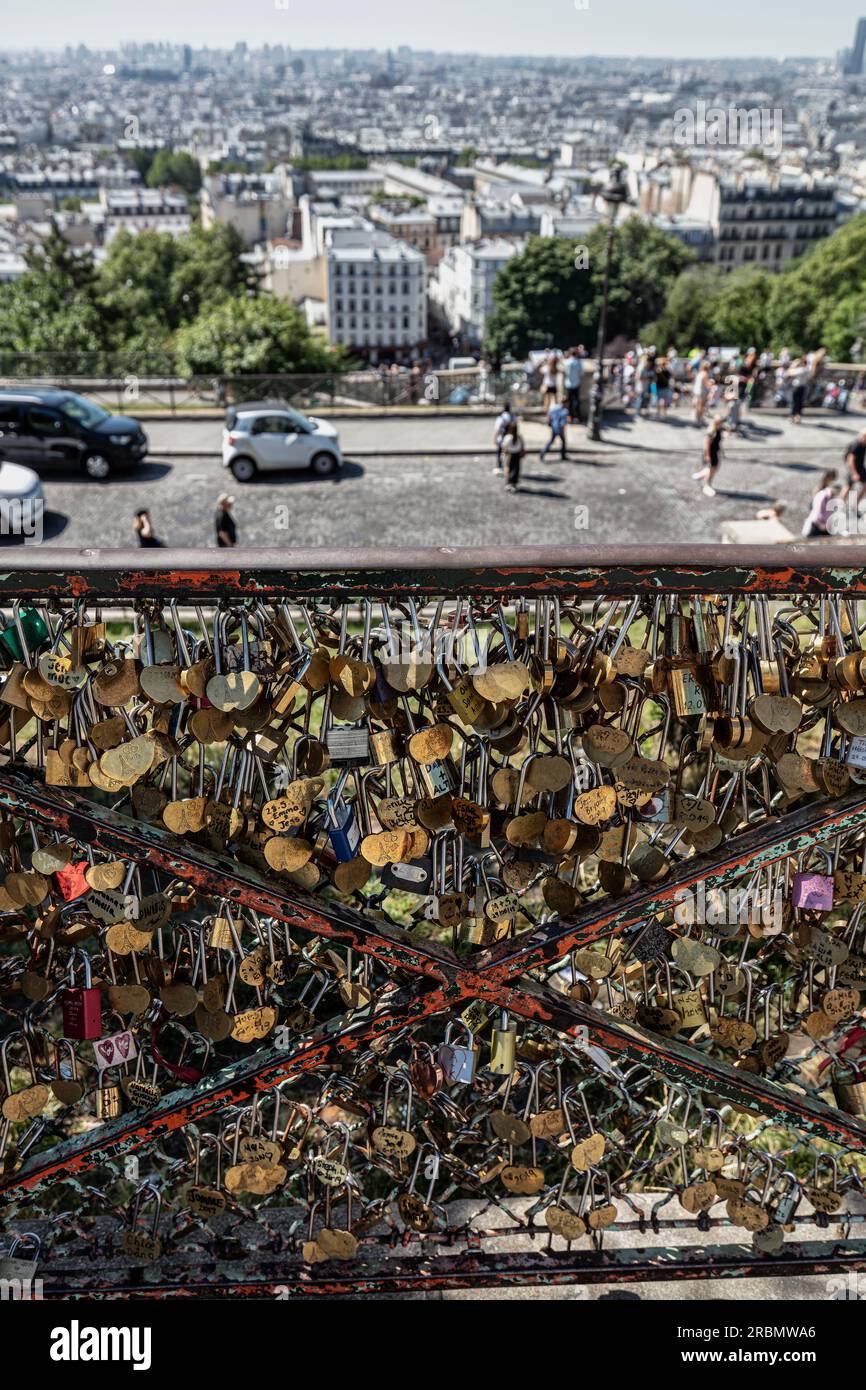The Sacré-Cœur Basilica and the Lost Locks of Love: A Montmartre Story
Perched atop the butte of Montmartre, the Sacré-Cœur Basilica stands as an iconic symbol of Paris, its gleaming white dome dominating the city skyline. This architectural masterpiece, a testament to faith and resilience, draws millions of visitors annually, captivated by its spiritual significance, breathtaking views, and rich history. For many years, however, the basilica was also associated with a more modern, albeit controversial, expression of devotion: love locks. These padlocks, inscribed with names or initials and often attached to bridges and fences, symbolized enduring love. While the locks have now been removed from the immediate vicinity of the basilica, their story remains intertwined with the site’s enduring appeal and raises broader questions about public art, environmental impact, and the evolving nature of love and commitment in the urban landscape.
A Basilica Born of Trauma: The Origins of the Sacré-Cœur
The Sacré-Cœur Basilica’s origins are deeply rooted in the tumultuous events of the Franco-Prussian War (1870-1871). France’s defeat in the war, coupled with the bloody suppression of the Paris Commune, left the nation reeling from trauma and seeking solace. Alexandre Legentil and Hubert Rohault de Fleury, prominent figures in Parisian society, attributed France’s misfortunes to a spiritual decline. They proposed the construction of a basilica dedicated to the Sacred Heart of Jesus as a national vow of penance and a plea for divine forgiveness.
The National Assembly officially approved the project in 1873, declaring it a matter of national importance. The choice of Montmartre as the site was highly symbolic. According to Christian tradition, Montmartre ("Mount of the Martyr") was where Saint Denis, the first Bishop of Paris, was beheaded in the 3rd century. Furthermore, during the Paris Commune, the hill served as a stronghold for the Communards, making it a site of political and social unrest. Building the basilica on this location was intended to atone for the sins of the Commune and reassert traditional Catholic values.
The architectural design was entrusted to Paul Abadie, who won a competition with his Romano-Byzantine style proposal. Construction began in 1875 and continued for nearly four decades, facing numerous delays due to political instability and funding challenges. The basilica was finally consecrated in 1919, after the end of World War I, solidifying its role as a symbol of national healing and hope.
An Architectural Marvel: Inside the Sacré-Cœur
The Sacré-Cœur Basilica is a masterpiece of architecture, distinguished by its dazzling white travertine stone, quarried from Château-Landon. The basilica’s exterior is characterized by its four domes, the most prominent being the central dome, which rises to a height of 83 meters (272 feet). Visitors can climb to the top of the dome for panoramic views of Paris, offering an unparalleled perspective of the city’s landmarks.
The interior of the basilica is equally impressive. The vast nave is adorned with stunning mosaics, stained glass windows, and sculptures. The most notable mosaic is the "Christ in Glory," one of the largest mosaics in the world, which depicts Jesus Christ with outstretched arms, surrounded by saints and angels. The basilica’s stained glass windows bathe the interior in a soft, ethereal light, creating a serene and contemplative atmosphere. The overall design encourages a sense of awe and reverence, inviting visitors to reflect on their faith and the basilica’s historical significance.
Montmartre’s Magnetic Pull: A Hub of Art and Romance
Beyond its religious significance, the Sacré-Cœur Basilica is inextricably linked to the vibrant artistic and bohemian culture of Montmartre. In the late 19th and early 20th centuries, Montmartre was a haven for artists, writers, and musicians, including renowned figures like Pablo Picasso, Henri Matisse, and Vincent van Gogh. The neighborhood’s affordable rents, lively cafes, and artistic atmosphere attracted creative minds from all over the world.
The Place du Tertre, located just steps from the basilica, remains a popular destination for artists, who create and sell their works to tourists. The charming streets of Montmartre are filled with art galleries, studios, and cabarets, preserving the neighborhood’s artistic heritage. The Moulin Rouge, a legendary cabaret known for its extravagant performances, is another iconic landmark in Montmartre, adding to the area’s allure and reputation for entertainment.
The romantic atmosphere of Montmartre, with its winding streets, charming cafes, and breathtaking views, has made it a popular destination for couples. The Sacré-Cœur Basilica, with its spiritual aura and stunning vistas, serves as a backdrop for countless romantic moments, attracting lovers from around the globe. It is within this context of romance and devotion that the phenomenon of love locks began to take hold.
The Rise and Fall of the Love Locks: A Symbol of Enduring Love
The practice of attaching love locks to bridges and fences as a symbol of enduring love is believed to have originated in Europe in the early 2000s. The trend quickly spread to other cities around the world, including Paris. The Pont des Arts, a pedestrian bridge spanning the Seine River, became the most famous location for love locks in Paris, attracting thousands of couples who attached padlocks to the bridge’s railings.
As the number of love locks grew, they began to appear on other structures throughout the city, including the fences surrounding the Sacré-Cœur Basilica. Couples would write their names or initials on the locks, often along with a date or a short message of love. After attaching the lock, they would throw the key into the Seine River or, in the case of the Sacré-Cœur, over the hillside, symbolizing the unbreakable nature of their bond.
The love locks became a popular tourist attraction, drawing visitors who were eager to participate in the romantic tradition. Photographs of the locks, with the Sacré-Cœur Basilica in the background, became ubiquitous on social media, further popularizing the practice. For many, the love locks represented a tangible expression of their commitment and a lasting memory of their time in Paris.
The Dark Side of Love: Environmental Concerns and Aesthetic Degradation
However, the proliferation of love locks also raised significant concerns. The sheer weight of the locks began to damage the structures to which they were attached. In 2014, a section of the Pont des Arts collapsed under the weight of the locks, prompting the city to take action.
Beyond the structural damage, the love locks were also criticized for their aesthetic impact. Many viewed them as unsightly and a form of vandalism, detracting from the beauty of Paris’s historic landmarks. The locks also posed environmental concerns, as the metal could corrode and pollute the river.
In 2015, the city of Paris began removing the love locks from the Pont des Arts and other bridges. The railings were replaced with panels of plexiglass to prevent future lock attachments. The city also launched a campaign to encourage alternative expressions of love, such as taking photos or making donations to charity.
The Sacré-Cœur’s Lock Legacy: A Lasting Impression
While the love locks have been officially removed from the fences surrounding the Sacré-Cœur Basilica, the memory of their presence lingers. Traces of the locks can still be seen on some of the metalwork, serving as a reminder of the phenomenon. The basilica remains a popular destination for couples, who continue to seek out romantic moments against its stunning backdrop.
The story of the love locks at the Sacré-Cœur Basilica is a complex one, reflecting the evolving nature of love and commitment in the modern world. While the practice may have been well-intentioned, its environmental and aesthetic consequences ultimately led to its demise. The basilica, however, endures as a symbol of faith, resilience, and the enduring power of love in all its forms. Visitors can still find ways to express their affection and create lasting memories at this iconic Parisian landmark, perhaps through a heartfelt embrace, a shared sunset view, or a quiet moment of reflection within the basilica’s hallowed walls. The Sacré-Cœur, after all, is more than just a building; it is a repository of stories, dreams, and the enduring human desire for connection.


